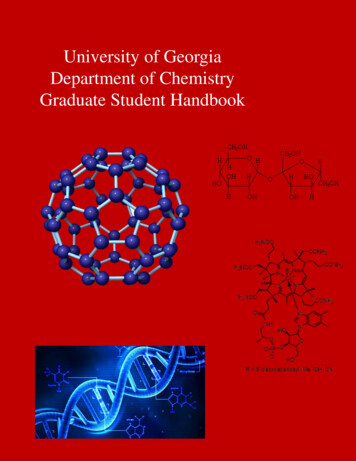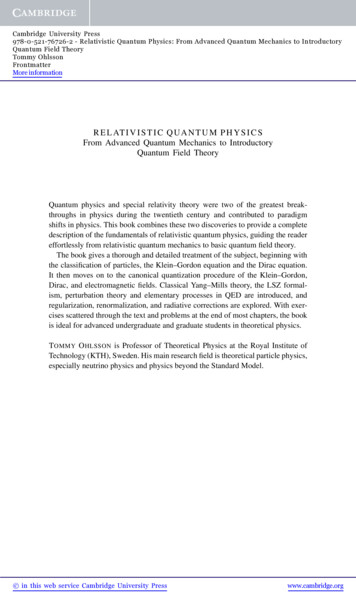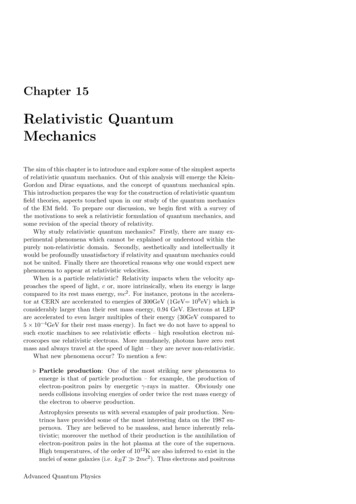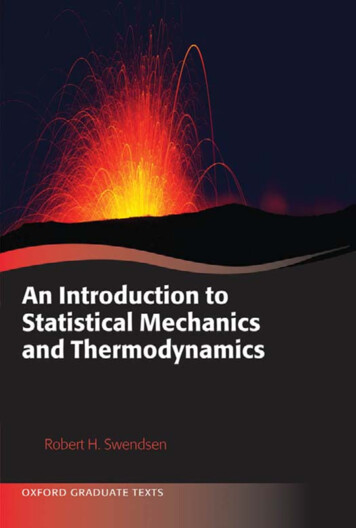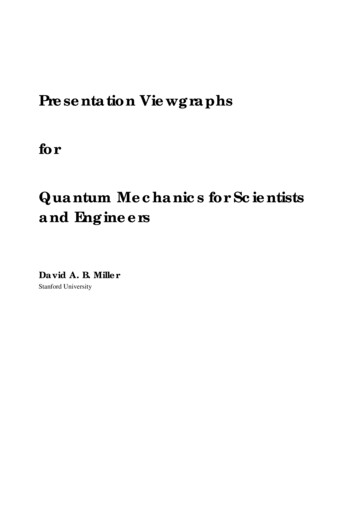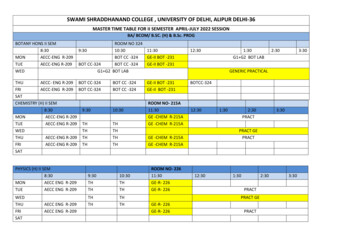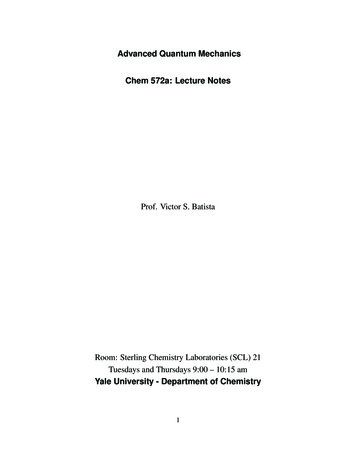
Transcription
Advanced Quantum MechanicsChem 572a: Lecture NotesProf. Victor S. BatistaRoom: Sterling Chemistry Laboratories (SCL) 21Tuesdays and Thursdays 9:00 – 10:15 amYale University - Department of Chemistry1
Contents1Syllabus62The Fundamental Postulates of Quantum Mechanics3Continuous Representations104Vector Space1013134.14.257911.16Fourier Grid Hamiltonian1819Computational Problem FGH . . . . . . . . . . . . . . . . . . . . . . . . . . . . .Variational Theorem19SOFT Method.2021222223232323252610.1 Problem 10 . . . . . . . . . . . . . . . . . . . . . . . . . . . . . . . . . . . . . .10.2 Problem 11 . . . . . . . . . . . . . . . . . . . . . . . . . . . . . . . . . . . . . .10.3 Computational Problem 12 . . . . . . . . . . . . . . . . . . . . . . . . . . . . . l Problem 1Computational Problem 2Computational Problem 3Computational Problem 41314151516Heisenberg Representation7.18Exercise 1 . . . . . . . . . . . . . . . . . . . . . . . . . . . . . . . . . . . . . . .Exercise 2 . . . . . . . . . . . . . . . . . . . . . . . . . . . . . . . . . . . . . . .Digital Grid-Based Representations5.15.25.35.467Computational Problem 5 . .Computational Problem 6 . .Computational Problem 7 . .Computational Problem 8 . .Computational Problem 9 . .Imaginary time propagation . . . . . . . . . . . . . . . . . . . . . . . . . . . . . . . . . . . . . . . . . . . . . . . . .Ehrenfest Dynamics . . . . . . . . .Exercise: Analytical versus SOFT PropagationExercise: Real and Imaginary Time Evolution .SOFT Propagation on Multiple SurfacesPath Integrals: Thermal Correlation Functions11.1 Exercise 13 . . . . . . . . . . . . . . . . . . . . . . . . . . . . . . . . . . . . . .11.2 Ring Polymer Implementation . . . . . . . . . . . . . . . . . . . . . . . . . . . .2293233
12SOFT Computations of Thermal Correlation Functions.343536384244.454548494914.1 Motion of Auxiliary Variables: . . . . . . . . . . . . . . . . . . . . . . . . . . . .14.2 Wigner-Weyl Symbols . . . . . . . . . . . . . . . . . . . . . . . . . . . . . . . .14.3 Stochastic equation of motion . . . . . . . . . . . . . . . . . . . . . . . . . . . .5052535712.112.212.312.412.51315.Hamilton Jacobi Equation . . . . . . . . . . . . .Quantum Dynamics: Motion of Hidden VariablesDiscussion of Bohmian Trajectories . . . . . . .EPR Paradox . . . . . . . . . . . . . . . . . . .Phase-Space RepresentationAsymmetric Wigner-Weyl Representation15.115.215.315.416.Bohmian Quantum Dynamics13.113.213.313.414Computational Problem 14 . . . . . . . . . . . . . . . . . . . .Relation of Kubo Transforms to standard TCF’s . . . . . . . . .Rates from two-point correlation functions . . . . . . . . . . . .Standard and Kubo three-point correlation function relationshipDetailed Balance Relation of the Second Order Kubo TransformTraces . . . . . . . . . . . . . . . . . .Equation of Motion . . . . . . . . . . .Stochastic Equation of Motion . . . . .Splitting integration of Hyperbolic PDEs.Golden Rule59616263656717 WKB Approximation17.1 Connection Formula . . . . . . . . . . . . .17.2 Normalization . . . . . . . . . . . . . . . . .17.3 Overlaps . . . . . . . . . . . . . . . . . . . .17.4 Energy Quantization . . . . . . . . . . . . .17.5 Computational Problem WKB Approximation.71727476787818 Electron Transfer: Marcus Theory7919 Landau-Zener Equation19.1 Marcus Formula . . . . . . . . . . . . . . . . . . . . . . . . . . . . . . . . . . . .808320 Tunneling Current8421Grover Algorithm893
22Second Quantization22.1 Single-Particle Basis . . . . . . . . . . . . . . . . . . . . . . . .22.2 Occupation Number Basis . . . . . . . . . . . . . . . . . . . . .22.3 Creation and Annihilation Operators . . . . . . . . . . . . . . . .22.4 Operators in Second Quantization . . . . . . . . . . . . . . . . .22.5 Change of basis in Second Quantization . . . . . . . . . . . . . .22.6 Mapping into Cartesian Coordinates . . . . . . . . . . . . . . . .22.7 Classical Electron Analog Hamiltonian . . . . . . . . . . . . . . .22.8 Wigner Transform Propagation based on the MM Hamiltonian . .22.9 Wigner Transform Propagation for the electronic MM Hamiltonian22.10Computational Problem 2-level WT . . . . . . . . . . . . . . . .93. 93. 94. 94. 95. 96. 97. 98. 100. 101. 10523Spin-Boson Model10524Holstein-Primakoff Mapping10725Schwinger Mapping10926MP/SOFT Method11027Exam 1113Answer Key . . . . . . . . . . . . . . . . . . . . . . . . . . . . . . . . . . 11427.128Discrete Variable Representation11828.1 Computational Problem 15 . . . . . . . . . . . . . . . . . . . . . . . . . . . . . . 121Tunneling Dynamics2912129.1 Coherent Control of Tunneling Dynamics . . . . . . . . . . . . . . . . . . . . . . 12229.2 Computational Problem 16 . . . . . . . . . . . . . . . . . . . . . . . . . . . . . . 12330Linear Photoabsorption Lineshape: A Time Dependent Picture 12331Time Dependent Perturbation Theory12632Nonlinear (Pump-Probe) Spectroscopy12933Pump-Probe Photoelectron Spectroscopy1303435Direct Photoelectron-Detachment Spectroscopy13334.1 Computational Problem 17 . . . . . . . . . . . . . . . . . . . . . . . . . . . . . . 133Exam 2135Answer Key . . . . . . . . . . . . . . . . . . . . . . . . . . . . . . . . . . 13735.14
36The Reaction Surface Hamiltonian Method14337 Exam 314537.1 Answer Key . . . . . . . . . . . . . . . . . . . . . . . . . . . . . . . . . . . . . . 14538Semiclassical Dynamics39Semiclassical Dynamics in the Gaussian-Hermite Basis4015015239.1 Multidimentional Semiclassical Dynamics . . . . . . . . . . . . . . . . . . . . . . 15439.2 Log Derivative Propagation . . . . . . . . . . . . . . . . . . . . . . . . . . . . . . 15539.3 Normalization of Multidimensional Gaussians . . . . . . . . . . . . . . . . . . . . 156Solutions to Computational Assignments40.1 Problem 1 . . . . . . . . . . . . .40.2 Problem 2 . . . . . . . . . . . . .40.3 Problem 3 . . . . . . . . . . . . .40.4 Problem 4 . . . . . . . . . . . . .40.5 Problem 5 . . . . . . . . . . . . .40.6 Problem 6 . . . . . . . . . . . . .40.7 Problem 7 . . . . . . . . . . . . .40.8 Problem 8 . . . . . . . . . . . . .40.9 Problem 9 . . . . . . . . . . . . .40.10 Problem 10 . . . . . . . . . . . . .40.11 Problem 11 . . . . . . . . . . . . .40.12 Problem 12 . . . . . . . . . . . . .40.13 Problem 12p . . . . . . . . . . . .40.14 Problem 15.1 . . . . . . . . . . . .40.15 Problem 15.2 . . . . . . . . . . . .40.16 Problem 15.3 . . . . . . . . . . . .40.17 Problem 15.4 . . . . . . . . . . . .40.18 Problem 16 . . . . . . . . . . . . .40.19 Problem 17 . . . . . . . . . . . . .40.20Computational Problem: WTP . . .40.21Computational Problem 2-level 289297305313331331333
1 SyllabusThe goal of this course is to introduce fundamental concepts of Quantum Mechanics with emphasison Quantum Dynamics and its applications to the description of molecular systems and their interactions with electromagnetic radiation. Quantum Mechanics involves a mathematical formulationand a physical interpretation, establishing the correspondence between the mathematical elementsof the theory (e.g., functions and operators) and the elements of reality (e.g., the observable properties of real systems). The presentation of the theory will be mostly based on the so-called OrthodoxInterpretation, developed in Copenhagen during the first three decades of the 20th century. However, other interpretations will be discussed, including the ’pilot-wave’ theory first suggested byPierre De Broglie in 1927 and independently rediscovered by David Bohm in the early 1950’s.Textbooks: The official textbook for this class is:R1:”Introduction to Quantum Mechanics: A Time-Dependent Perspective” by David J. Tannor(University Science Books).However, the lectures will be heavily complemented with material from other textbooks including:R2: ”Quantum Theory” by David Bohm (Dover),R3: ”Quantum Physics” by Stephen Gasiorowicz (Wiley),R4: ”Quantum Mechanics” by Claude Cohen-Tannoudji (Wiley Interscience),R5: ”Quantum Mechanics” by E. Merzbacher (Wiley),R6: ”Modern Quantum Mechanics” by J. J. Sakurai (Addison Wesley),All these references are ’on-reserve’ at the Kline science library.References to specific pages of the textbooks listed above are indicated in the notes as follows:R1(190) indicates “for more information see Reference 1, Page 190”.Furthermore, a useful mathematical reference is R. Shankar, Basic Training in Mathematics. AFitness Program for Science Students, Plenum Press, New York 1995.Useful search engines for mathematical and physical concepts can be found athttp://scienceworld.wolfram.com/physics/ and http://mathworld.wolfram.com/The lecture notes are posted online at: (http://ursula.chem.yale.edu/ batista/classes/v572/v572.pdf)Grading: There will be no final exam for this class. Midterms will be on February 19 and April23.The final grading evaluation is the same for both undergraduate and graduate students:homework (50%), and three mid-terms (50%).Homework includes exercises and computational assignments with due dates indicated in the lecture notes.Contact Information and Office Hours: Office hours will be held at SCL 162 uponrequest by the students via email to victor.batista@yale.edu.6
2The Fundamental Postulates of Quantum MechanicsQuantum Mechanics can be formulated in terms of a few postulates (i.e., theoretical principlesbased on experimental observations). The goal of this section is to introduce such principles, together with some mathematical concepts that are necessary for that purpose. To keep the notationas simple as possible, expressions are written for a 1-dimensional system. The generalization tomany dimensions is usually straightforward.P ostulate 1 : Any system in pure state can be described by a function ψ(t, x), where t is a parameter representing the time and x represents the coordinates of the system. Function ψ(t, x) must becontinuous, single valued and square integrable.Note 1: As a consequence of Postulate 4, we will see that P (t, x) ψ (t, x)ψ(t, x)dx representsthe probability of finding the system between x and x dx at time t.P ostulate 2 : Any observable (i.e., any measurable property of the system) can be described byan operator. The operator must be linear and hermitian.What is an operator ? What is a linear operator ? What is a hermitian operator?Definition 1: An operator Ô is a mathematical entity that transforms a function f (x) into anotherfunction g(x) as follows, R4(96)Ôf (x ) g(x ),where f and g are functions of x.Definition 2: An operator Ô that represents an observable O is obtained by first writing the classical expression of such observable in Cartesian coordinates (e.g., O O(x, p)) and then substituting the coordinate x in such expression by the coordinate operator x̂ as well as the momentum pby the momentum operator p̂ i / x.Definition 3: An operator Ô is linear if and only if (iff),Ô(af (x) bg(x)) aÔf (x) bÔg(x),where a and b are constants.Definition 4: An operator Ô is hermitian iff, Z Z dxψm (x)Ôφn (x) ,dxφn (x)Ôψm (x) where the asterisk represents the complex conjugate of the expression embraced by brackets.Definition 5: A function φn (x) is an eigenfunction of Ô iff,Ôφn (x) On φn (x),7
where On is a number called eigenvalue.Property 1: The eigenvalues of a hermitian operator are real.Proof: Using Definition 4, we obtain ZZ dxφn (x)Ôφn (x) dxφn (x)Ôφn (x) 0,therefore,[On On ]Zdxφn (x) φn (x) 0.Since φn (x) are square integrable functions, then,On On .Property 2: Different eigenfunctions of a hermitian operator (i.e., eigenfunctions with differenteigenvalues) are orthogonal (i.e., the scalar product of two different eigenfunctionsis equal toRzero). Mathematically, if Ôφn On φn , and Ôφm Om φm , with On 6 Om , then dxφ n φm 0.Proof: Z Zdxφ m Ôφn anddxφ n ÔφmZ[On Om ]Since On 6 Om , thenR 0,dxφ m φn 0.dxφ m φn 0.P ostulate 3 : The only possible experimental results of a measurement of an observable are theeigenvalues of the operator that corresponds to such observable.P ostulate 4 : The average value of many measurements of an observable O, when the system isdescribed by function ψ(x), is equal to the expectation value Ō, which is defined as follows,Rdxψ(x) Ôψ(x)Ō R.dxψ(x) ψ(x)P ostulate 5 :The evolution of ψ(x, t) in time is described by the following equation:i 2 ψ(x, t) Ĥψ(x, t), t2 where Ĥ 2m V̂ (x), is the operator associated with the total energy of the system, E x2p2 V (x).2m8
Expansion P ostulate : R5(15), R4(97)The eigenfunctions of a linear and hermitian operator form a complete basis set. Therefore,any function ψ(x) that is continuous, single valued, and square integrable can be expanded as alinear combination of eigenfunctions φn (x) of a linear and hermitian operator  as follows,Xψ(x) Cj φj (x),jwhere Cj are numbers(e.g., complex numbers)P called expansion coefficients.P Note that Ā j Cj Cj aj , when ψ(x) j Cj φj (x),ZÂφj (x) aj φj (x),anddxφj (x) φk (x) δjk .This is because the eigenvalues aj are the only possible experimental results of measurements of Â(according to Postulate 3), and the expectation value Ā is the Paverage value of many measurementsof  when the system is described by the expansion ψ(x) j Cj φj (x) (Postulate 4). Therefore,the product Cj Cj can be interpreted as the probability weight associated with eigenvalue aj (i.e.,the probability that the outcome of an observation of  will be aj ).Hilbert-SpaceAccording to the Expansion Postulate (together with Postulate 1), the state of a system describedby the function Ψ(x) can be expanded as a linear combination of eigenfunctions φj (x) of a linearand hermitian operator (e.g., Ψ(x) C1 φ1 (x) C2 φ2 (x) . . .). Usually, the space defined bythese eigenfunctions (i.e., functions that are continuous, single valued and square integrable) hasan infinite number of dimensions. Such space is called Hilbert-Space in honor to the mathematicianHilbert who did pioneer work in spaces of infinite dimensionality.R4(94)A representation of Ψ(x) in such space of functions corresponds to a vector-function,φ2 (x)6C2.ψ(x) .C1-φ1 (x)where C1 and C2 are the projections of Ψ(x) along φ1 (x) and φ2 (x), respectively. All othercomponents are omitted from the representation because they are orthogonal to the “plane” definedby φ1 (x) and φ2 (x).9
3Continuous RepresentationsCertain operators have a continuous spectrum of eigenvalues. For example, the coordinate operatoris one such operator since it satisfies the equation x̂ δ(x0 x) x0 δ(x0 x), where the eigenvaluesx0 define a continuum. Delta functions δ(x0 x) thus define a continuous representation (the socalled ’coordinate representation’) for whichZψ(x) dx0 Cx0 δ(x0 x),where Cx0 ψ(x0 ), sinceZZZdxδ(x β)ψ(x) dx dαCα δ(x β)δ(α x) ψ(β).When combined with postulates 3 and 4, the definition of the expansion coefficients Cx0 ψ(x0 ) implies that the probability of observing the system with coordinate eigenvalues between x0and x0 dx0 is P (x0 ) Cx0 Cx 0 dx0 ψ(x0 )ψ(x0 ) dx0 (see Note 1).In general, eigenstates φ(α, x) with a continuum spectrum of eigenvalues α define continuousrepresentations,Zψ(x) dαCα φ(α, x),Rwith Cα dxφ(α, x) ψ(x). Delta functions and the plane waves are simply two particularexamples of basis sets with continuum spectra.Note 2: According to the Expansion Postulate, a function ψ(x) is uniquely and completely definedby the coefficients Cj , associated with its expansion in a complete set of eigenfunctions φj (x).However, the coefficients of such expansion would be different if the same basis functions φjdepended on different coordinates (e.g., φj (x0 ) with x0 6 x). In order to eliminate such ambiguityin the description it is necessary to introduce the concept of vector-ket space.R4(108)4Vector SpaceVector-Ket Space ε: The vector-ket space is introduced to represent states in a convenient spaceof vectors φj , instead of working in the space of functions φj (x). The main difference is thatthe coordinate dependence does not need to be specified when working in the vector-ket space.According to such representation, function ψ(x) is the componentof vector ψ associated withPindex x (vide infra). Therefore, for any function ψ(x) j Cj φj (x), we can define a ket-vector ψ such that,X ψ Cj φj .jThe representation of ψ in space ε is,10
Ket-Space ε φ2 6C2. . ψ .C1- φ1 Note that the expansion coefficients Cj depend only on the kets ψj and not on any specificvector component. Therefore, the ambiguity mentioned above is removed.In order to learn how to operate with kets we need to introduce the bra space and the concept oflinear functional. After doing so, this section will be concluded with the description of Postulate5, and the Continuity Equation.Linear functionalsA functional χ is a mathematical operation that transforms a function ψ(x) into a number. Thisconcept is extended to the vector-ket space ε, as an operation that transforms a vector-ket into anumber as follows,χ(ψ(x)) n,orχ( ψ ) n,where n is a number. A linear functional satisfies the following equation,χ(aψ(x) bf (x)) aχ(ψ(x)) bχ(f (x)),where a and b are constants.Example: The scalar product,R4(110)Zn dxψ (x)φ(x),is an example of a linear functional, since such an operation transforms a function φ(x) into anumber n. In order to introduce the scalar product of kets, we need to introduce the bra-space.Bra Space ε : For every ket ψ we define a linear functional ψ , called bra-vector, as follows:R ψ ( φ ) dxψ (x)φ(x).Note that functional ψ is linear because the scalar product is a linear functional. Therefore, ψ (a φ b f ) a ψ ( φ ) b ψ ( f ).11
Note: For convenience, we will omit parenthesis so that the notation ψ ( φ ) will be equivalentto ψ φ . Furthermore, whenever we find two bars next to each other we can merge them intoa single one without changing the meaning of the expression. Therefore, ψ φ ψ φ .P The space of bra-vectors is called dual spaceεsimplybecausegivenaket ψ j Cj φj ,P the corresponding bra-vector is ψ j Cj φj . In analogy to the ket-space, a bra-vector ψ is represented in space ε according to the following diagram:Dual-Space ε φ2 6C2 . . ψ . C1- φ1 where Cj is the projection of ψ along φj .Projection Operator and Closure RelationGiven a ket ψ in a certain basis set φj , ψ XCj φj ,(1)jwhere φk φj δkj ,Cj φj ψ .(2)Substituting Eq. (2) into Eq.(1), we obtain ψ X φj φj ψ .jFrom Eq.(3), it is obvious thatX φj φj 1̂,Closure Relationjwhere 1̂ is the identity operator that transforms any ket, or function, into itself.12(3)
Note that P̂j φj φj is an operator that transforms any vector ψ into a vector pointingin the direction of φj with magnitude φj ψ . The operator P̂j is called the ProjectionOperator. It projects φj according to,P̂j ψ φj ψ φj .Note that P̂j2 P̂j , where P̂j2 P̂j P̂j . This is true simply because φj φj 1.4.1Exercise 1Prove thati P̂j [Ĥ, P̂j ], twhere [Ĥ, P̂j ] Ĥ P̂j P̂j Ĥ.Continuity Equation4.2Exercise 2Prove thatwhere (ψ (x, t)ψ(x, t)) j(x, t) 0, t x ψ (x, t) ψ(x, t) j(x, t) ψ(x, t)ψ (x, t).2mi x xIn general, for higher dimensional problems, the change in time of probability density, ρ(x, t) ψ (x, t)ψ(x, t), is equal to minus the divergence of the probability flux j, ρ(x, t) · j. tThis is the so-called Continuity Equation.Note: Remember that given a vector field j, e.g., j(x, y, z) j1 (x, y, z)î j2 (x, y, z)ĵ j3 (x, y, z)k̂, the divergence of j is defined as the dot product of the “del” operator ( x, y, z) and vector jas follows: j1 j2 j3 ·j . x y z5Digital Grid-Based RepresentationsThe standard formulation of quantum mechanics, presented in previous sections, relies upon thetools of calculus (e.g., derivatives, integrals, etc.) and involves equations and operations with infinitesimal quantities as well as states in Hilbert-space (the infinite dimensional space of functions13
L2 ). The equations, however, seldom can be solved analytically. Therefore, computational solutions are necessary. However, computers can not handle infinite spaces since they have only limitedmemory. In fact, all they can do is to store and manipulate discrete arrays of numbers. Therefore,the question is: how can we represent continuum states and operators in the space of memory ofdigital computers?In order to introduce the concept of a grid-representation, we consider the state,Ψ0 (x) α 1/4παe 2 (x x0 )2 ip0 (x x0 ),which can be expanded in the infinite basis set of delta functions δ(x x0 ) as follows,ZΨ0 (x) dx0 c(x0 )δ(x x0 ),(4)(5)where c(x0 ) hx0 Ψ0 i Ψ0 (x0 ). All expressions are written in atomic units, so 1.A grid-based representation of Ψ0 (x) can be obtained, in the coordinate range x (xmin , xmax ),by discretizing Eq. (5) as follows,Ψ0 (x) nXcj δ(x xj ),(6)j 1where the array of numbers cj hxj Ψ0 i represent the state Ψ0 on a grid of equally spaced coordinates xj xmin (j 1) with finite resolution (xmax xmin )/(n 1).Note that the grid-based representation, introduced by Eq. (6), can be trivially generalized toa grid-based representation in the multidimensional space of parameters (e.g., xj , pj , γj , . etc.)when expanding the target state Ψ0 (x) as a linear combination of basis functions hx xj , pj , γj i, withexpansion coefficients as cj hxj , pj , γj Ψ0 i.5.1Computational Problem 1Write a computer program to represent the wave-packet, introduced by Eq. (4) on a grid of equallyspaced coordinates xj xmin (j 1) with finite resolution (xmax xmin )/(n 1) andvisualize the output. Choose x0 0 and p0 0, in the range x (-20,20), with α ωm, wherem 1 and ω 1.Next, we consider grid-based representations in momentum space:Ψ0 (p) hp Ψ0 i.RInserting the closure relation 1̂ dx xihx in Eq. (7), we obtain thatZZ 1/2hp Ψ0 i dxhp xihx Ψ0 i (2π)dxe ipx hx Ψ0 i.14(7)(8)
is the Fourier transform of the initial state. The second equality in Eq. (8) was obtained by using:hx pi (2π) 1/2 eipx ,(9)which is the eigenstate of the momentum operator p̂ i , with eigenvalue p, since p̂hx pi phx pi.The Fourier transform can be computationally implemented in O(N log(N )) steps by usingthe Fast Fourier Transform (FFT) algorithm [see, Ch. 12 of Numerical Recipes by W.H. Press,B.P. Flannery, S.A. Teukolsky and W.T. Vetterling, Cambridge University Press, Cambridge, 1986[FFT] when hx Ψ0 i is represented on a grid with N 2n points (where n is an integer). In contrast,the implementation of the Fourier transform by quadrature integration would require O(N 2 ) steps.5.2Computational Problem 2Write a computer program to represent the initial state, introduced by Eq. (4), in the momentumspace by applying the FFT algorithm to the grid-based representation generated in Problem 1 andvisualize the output. Represent the wave-packet amplitudes and phases in the range p (-4,4) andcompare your output with the corresponding values obtained from the analytic Fourier transformobtained by using:Zpdx exp( a2 x2 a1 x a0 ) π/a2 exp(a0 a21 /(4a2 )).Next, we consider the grid-based representation of operators (e.g., x̂, p̂, V (x̂), and T̂ p̂2 /(2m))and learn how these operators act on states represented on grids in coordinate and momentumspaces. For simplicity, we assume that the potential is Harmonic:1V (x̂) mω 2 (x̂ x̄)2 .2(10)Consider first applying the potential energy operator to the initial state, as follows,V (x̂)Ψ0 (x) V (x)Ψ0 (x) Ψ̃0 (x).(11)Since Ψ̃0 (x) is just another function, Eq. (11) indicates that V (x̂) can be represented on the samegrid of coordinates as before (i.e., equally spaced coordinates xj xmin (j 1) , with finiteresolution (xmax xmin )/(n 1)). Since for each xj , Ψ̃0 (xj ) V (xj )Ψ(xj ), the operatorV (x̂) can be represented just as an array of numbers V (xj ) associated with the grid-points xj , andits operation on a state is represented on such a grid as a simple multiplication.5.3Computational Problem 3Write a computer program to compute the expectation values of the position x(0) hΨ0 x̂ Ψ0 iand the potential energy V hΨ0 V (x̂) Ψ0 i, where V (x) is defined according to Eq. (10) for the15
initial wave-packet, introduced by Eq. (4), with various possible values of x0 and p0 , with α ωm,where m 1 and ω 1.Now consider applying the momentum operator, p̂ i , to the initial state Ψ0 (x) as follows,G(x) hx p̂ Ψ0 i i Ψ0 (x).(12)One simple way of implementing this operation, when Ψ0 (x) is represented on a grid of equallyspaced points xj xmin (j 1) , is by computing finite-increment derivatives as follows:G(xj ) iΨ0 (xj 1 ) Ψ0 (xj 1 ).2 (13)However, for a more general operator (e.g., T̂ p̂2 /(2m)) this finite increment derivative procedure becomes complicated. In order to avoid computing finite-increment derivatives, one canimplement an alternative procedure: represent the initial state in momentum-space (by Fouriertransform of the initial state); apply the operator by simple multiplication in momentum space,then transform the resulting product back to the coordinate representation (byR inverse-Fourier transform). This method can be derived by inserting the closure relation 1̂ dp pihp , in Eq. (12),ZG(x) hx p̂ Ψ0 i 1/2dphx p̂ pihp Ψ0 i (2π)Zdpeipx php Ψ0 i,(14)since hp Ψ0 i is defined, according to Eq. (8), as the Fourier transform of the initial state. Note thatthe second equality of Eq. (14) is obtained by introducing the substitutionhx pi (2π) 1/2 eixp̂ .(15)While Eq. (14) illustrates the method for the specific operator p̂, one immediately sees that anyoperator which is a function of p̂ (e.g., T̂ p̂2 /(2m)) can be analogously applied according to theFourier transform procedure.5.4Computational Problem 4Write a computer program to compute the expectation values of the initial momentum p(0) hΨ0 p̂ Ψ0 i and the kinetic energy T hΨ0 p̂2 /(2m) Ψ0 i by using the Fourier transform procedure,where Ψ0 is the initial wave-packet introduced by Eq. (4), with x0 0, p0 0, and α ωm,where m 1 and ω 1. Compute the expectation value of the energy E hΨ0 Ĥ Ψ0 i, whereĤ p̂2 /(2m) V (x̂), with V (x) defined according to Eq. (10) and compare your result with thezero-point energy E0 ω/2.6Heisenberg RepresentationMost of the problems of interest in Chemistry have equations that are too complicated to be solvedanalytically. This observation has been stated by Paul Dirac as follows: The underlying physical16
laws necessary for the mathematical theory of a large part of Physics and the whole of Chemistryare thus completed and the difficulty is only that exact application of these laws leads to the equations much too complicated to be soluble. It is, therefore, essential, to introduce numerical andapproximate methods (e.g., perturbation methods and variational methods).In this section, we describe the matrix representation, introduced by Heisenberg, which is mostuseful for numerical methods to solve the eigenvalue problem,R4(124) R3(240)Ĥ ψl i El ψl i,(16)for an arbitrary state ψl i of a system (e.g., an atom, or molecule) expanded in a basis set {φj }, asfollows:X (j) ψl i Cl φj i,(17)j(j)where Cl hφj ψl i, and hφj φk i δjk . Substituting Eq. (17) into Eq. (16) we obtain:XX(j)(j)Ĥ φj iCl El Cl φj i.jjApplying the functional hφk to both sides of this equation, we obtain:XX(j)(j)hφk Ĥ φj iCl El hφk φj iCl ,j(18)jwhere hφk φj i δkj and k 1, 2, ., n.Introducing the notation Hkj hφk Ĥ φj i we obtain, (1)(2)(3)(n)(1)(2)(n)H11 Cl H12 Cl H13 Cl . H1n Cl El Cl 0Cl . 0Cl ,(k 1) (1)(2)(3)(n)(1)(2)(n) (k 2) H21 Cl H22 Cl H23 Cl . H2n Cl 0Cl El Cl . 0Cl ,. .(k n) H C (1) H C (2) H C (3) . H C (n) 0C (1) 0C (2) . E C (n) ,n1 ln2 ln3 lnn ll lll(19)that can be conveniently written in terms of matrices and vectors as follows, (1) (1) CCH11 H12 . H1nEl 0 . 0l l(2) (2) H21 H22 . H2n Cl 0 El . 0 Cl (20) . . . . . (n)(n)Hn1 Hn2 . Hnn0 0 . ElClClThis is the Heisenberg representation of the eigenvalue problem introduced by Eq. (16). Accordingto the Heisenberg representation, also called matrix representation, the ket ψl i is represented by(j)the vector Cl , with components Cl hφj ψl i, with j 1, .,
2 The Fundamental Postulates of Quantum Mechanics Quantum Mechanics can be formulated in terms of a few postulates (i.e., theoretical principles based on experimental observations). The goal of this section is to introduce such principles, to-gether with some mathematical concepts that are necessary for that purpose. To keep the notation
